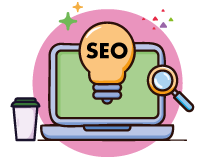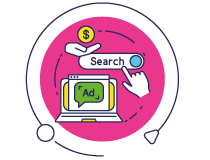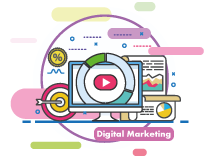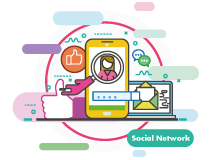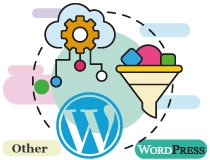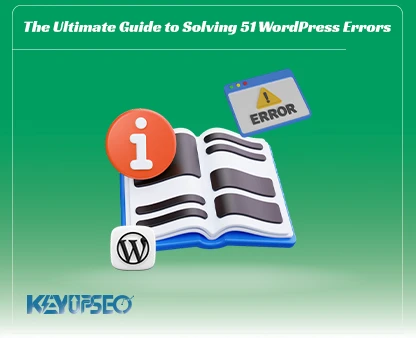
Everything you need to know about UX design
To design a user-friendly website, you need to know what user experience is and how to have a basic UX design.
In website design, it is not just about beautiful appearance, you must consider the user's comfort and proper access to all elements of the site.
If your site has a good UI and UX, the user will be more engaged with the site and stay there for longer. On the other hand, if it easily reaches its goal, it will come back again, so you should not ignore this issue easily.
Following these points will improve website SEO.
In this article, we explain what user experience is, what it is for us, and what a UX designer should do.
Stay tuned with KeyUpSeo.
What is User Experience or UX?
The International Organization for Standardization (ISO) defines user experience as follows:
User Experience, abbreviated as UX, includes a user's behaviors, attitudes, and feelings about using a specific product, system, or service. In human-computer interaction, there are practical aspects and valuable and meaningful experiences for the user that affect him emotionally and change his feelings.
Simply put, user experience is the user's feedback when using your products or services; in other words, what does the user feel and think when using your product?
The term user experience was first used by Don Norman in the 80s, but its concept has existed long before that. For centuries, humans have sought to optimize their surroundings for maximum user comfort. Even since the time of primitive humans, everyone has been looking for a better user experience, otherwise, so many inventions for human comfort would not have been created until now.
Without exaggeration, the most important principle in good UX design is to present the best solution to the user without any complexity or difficulty. Following this principle, observing simplicity and elegance in what we offer to the user is of great importance in increasing the quality of the user experience.
Of course, the ease of use of the product is not the only criterion. Products like the iPhone that have excellent UX pay attention not only to its usability and ease of use but also to other aspects such as pleasure, efficiency, and entertainment.
What is UX Design?
UX Design means designing the product and work process in a simple, hassle-free, and beautiful way for the user so that he has a good experience at all stages of working with your system and feels completely satisfied.
In simpler terms, design the elements and process in such a way that using your product and service is easy, efficient, and enjoyable.
These days, the UX market in the world of software, websites, and games is very hot and competitive; Because everyone knows that users spend most of their time in the virtual world. Well, wherever the user is, there is also the user experience. Of course, UX is not limited to the world of the Internet and software; but in the digital world, paying attention to UX becomes much more important; because the user can quickly find an alternative to your site and software.
What is the importance of UX Design?
Suppose you have entered an online store, in the first stage it takes you 10–15 seconds to load. When you enter the product page, you see the product description and there is only one photo of the product. There are no photos of other views of the product. These make you hesitate a little, but since it is discounted and the price is a little lower than elsewhere, you decide to buy.
You look for the buy button. You won't find it. Furthermore, you scroll a lot, and you see the buy button at the bottom right. You click to add it to your cart, but it sends you to the checkout page; meaning if you want to buy something else, you have to go back and search again.
From the very beginning, you had a bad experience at every step, and you said in your mind that if the purchase process was different, it would have been better.
User Experience Design means designing all these steps in such a way that everything is completely easy and accessible for the user. From the moment you enter to receiving goods and services and even using the product!
A company needs a UX specialist to be aware of all these events so that these unpleasant feelings do not arise in the customer. In the next section, we are going to talk about the work of a UX designer.
Who is a UX designer?
Before explaining the work of a UX designer, we must first know what the purpose of UX design is?
As I said, the purpose of UX design is to create desirable, easy, efficient, and appropriate experiences in all areas of a product. From the selection and purchase process to its use by the user.
Well, now there must be someone to analyze all the elements that create these experiences. This person must analyze how this product or service makes the user feel at all stages. Has the user been provided with the things they wanted? And how easy it is to use.
The work of a UX designer starts when there is no product yet. His first job is to identify customers and their needs, and if there are similar products, see what problems people have with them.
By evaluating the good and bad experiences of users, he offers different solutions for each, which of course requires scientific and technical research; Ultimately, the best way is chosen based on the user's comfort and interests.

What exactly does a UX designer do?
Sometimes a designer has to put themselves in the user's shoes to see what the user's behavior and feelings about the product might be. For example, when designing a site or application, the designer considers every activity that the user is going to do and for each, offers the simplest, most beautiful, most efficient way that will have the best feedback.
It is becoming clear that the job of a user experience designer is not that easy. This was just a simple and conceptual explanation of this widely used job, and in practice, it requires a variety of skills. It seems that a UX designer must have both management knowledge and marketing and sales!! He must have information about visual design and aesthetics, and be able to step into the shoes of psychologists. Technical information has its place. Because he is supposed to be present at all stages of product development.
You should keep in mind that to create a unique user experience, it is essential to have multidisciplinary coordination between different parts of your company and to utilize experts in marketing, graphics, design, data mining, and everything that deals with the user.
Don Norman, the creator of the term user experience
Don Norman joined Apple in the early 90s as a UX designer and was the first person to have such a title on his resume. He was supposed to examine all aspects of the user experience with a system, from the beginning of the process with an idea, industrial design, graphics, user interface, physical interaction, and everything that was supposed to affect the user and to provide the best solutions.
Maybe if Mr. Norman had come to your company with such a title at that time, you would not have let him go at all and would have said, what kind of job is a UX designer anymore? We don't need such a thing. But today you see that a researcher or UX designer is a key player in companies; Because everyone now understands how important user experience is and how much it can impact their reputation.
What is the use of user experience?
Consider a business website. If the site loads too slowly, or is too complicated and busy, you will feel very bad, and you will not have a good experience. You may not even remember the name of the site and will not use this site again.
In contrast, imagine another site that has the same content very smoothly and conveniently placed side by side and on a beautiful and secluded page, and you can easily access everything you require.
This means two different user experiences and the impression that using two different sites leaves in the user’s mind. Continuing this story, I must say that these experiences and feelings are so significant that they greatly affect the user’s decision to purchase and use products and services again.
This example shows that the value of UX design is not only great for the user, but also for the SEO of your website and your business and brand.
I recommend reading the article Impact of UX on SEO and Site Rankings.
From a business perspective, user experience design is the key to customer satisfaction and loyalty. If a product is easy and enjoyable for a user to use, they will want to use it again, but a dissatisfied user may never come back.
So now that we understand the importance of UX to this extent, let's read the factors impacting User Experience.
Characteristics of Ideal UX Design
The answer to this question may not be easy at first. Because the user experience design for each product or business should be unique and take into account the details related to it.
But in my searches for this article, I came across an interesting model by Peter Marvell, which I guess considering its elements can help to achieve an ideal user experience.
Just note that at first glance, these characteristics may not be for UX. But if we look deeper, we will understand that the presence or absence of each of these items makes UX and user experiences.
-
Be useful
The product you offer in the form of user experience should exactly meet the needs of the audience. You should know that if the gap desired by the audience is not filled, they will not have the motivation to use your product or service.
-
Be usable
The system in which the product or service is offered should be as simple and easy to use as possible. Simplicity and ease of understanding of the product should be the first point to be considered in a good UX design.
-
User-friendly
Your product or service should be aesthetically appealing and at the same time easy to interpret. Make the design as minimal and purposeful as possible.
-
Searchable
In this section, the user should be able to find your product or service easily. This one is very obvious; if you look for something and don't find it, you skip it and move on to the next options! So the information you expose to the audience should be eye-catching and at the same time easy to browse. If the user has a problem, they should be able to find the solution to it very quickly on your page.
-
Accessible
Accessibility in the user experience of the product or service means that the design is designed in a way that can be used by all people of all abilities. Even people with disabilities who have hearing, vision, mobility, or learning disabilities. I have seen less attention to this issue, perhaps because companies think that they are wasting their financial resources by doing this because disabled people are a small part of society. But anyway, they are also part of your audience and by considering this issue, you have fulfilled your social responsibility in a way. And most importantly, when you consider people with less ability in your design, it becomes easier for other people to use it.
-
Be trustworthy
Randall Terry says: “If you fool me once, shame on you. If you fool me twice, shame on me.”
This sentence exactly clarifies the concept of being trustworthy. If a user distrusts you the first time they use your product or service, they will not give you a second chance to repeat the bad experience they had. Because there are many options for the customer to replace you.
So paying attention to this is also very important. Every audience expects to perceive a reliable and trust-filled experience when encountering your product or service, and in short, in user experience design we must be able to gain the user's trust for future uses of our product.

What are the steps of UX design?
User experience design for each product or service has its own unique story. To the extent that sometimes two similar products may have different user experience designs depending on the type of audience they serve. Despite all these differences, the following four common steps can be considered in user experience design for all products or services.
Join us in this keyupseo blog article to learn about the steps of UX design.
-
Research
Matthew Wakeman says in his book Practical UX Research Techniques for Better Product Design:
If I only have an hour to solve a problem, I spend two-thirds of it trying to figure out what the problem is.
According to this statement, the most important thing is to figure out what you need to solve? What you need to improve? What will make your product more memorable to the user?
So consider two things in this section:
Researching users is key to solving the issue
You need to know who your customers are? What are their interests? What are their needs? What are the challenges they face with your product?
You can do this by conducting surveys or, if you have a customer service department, by asking them for help. This group is always on the receiving end of customers’ pain and has a lot of information. Why go the extra mile? You’ve probably seen the comments people leave on your social media. These comments are full of experiences that users express. Rest assured, many ideas come out of their hearts.
For example, someone says, why doesn't your product post have a price? This means that the user doesn't feel good about coming up and asking for a price. Or maybe they feel that the prices are too high and haven't been announced (their trust is diminished). These become bad user experiences. In short, you have several ways to understand the wants, needs, and behavior of your audience.
Don't forget to pay attention to the goals and vision of the business
Another point is that we carefully explore the goals and vision of the business to better understand what image or experience the audience or customer is going to get from the brand. This stage of user experience design is very similar to marketing research projects and is mostly used for new products.
-
Data Analysis
In this stage, we try to analyze the data we obtained through previous research. Analyzing this information helps us understand the user's behavior and the challenges they face when dealing with our products or services, and ultimately, from the challenges and needs of the audience, we arrive at the weaknesses of the product that do not create a good experience for the audience.
-
Concept Design (Initial Concept)
Well, now that we have obtained good information, we start creating and designing new ideas. Of course, our ideas must be in line with both the behavior and interests of the audience and the goals and visions of our organization. This process continues until we can reach the simplest and best design and solution.
This stage is like a building plan, in which all the work that needs to be done is clear and awaits the skeleton and appearance (UI).
-
Final Design
After our concept version or prototype is completed, we hand it over to the designers to turn it into a new service. If we assume that our product is going to be a web page, at this stage the graphic designer must transform the decision we have made about our user experience into what is intended using color, image, and detail. After the initial design is completed, we hand the package over to the coding department to carry out the design implementation process.
Comparison of UX and UI
Some website designers use an interesting quote:
User interface (UI) without using User Experience (UX) is like a painter spraying paint on a canvas without having a design in mind. On the other hand, user experience design without considering the user interface is like using a frame for a work of art without being able to fit the appropriate design in it.
Therefore, the best experience of using a service or product is achieved when an attractive user interface is presented to the audience with user experience considerations.

What is the difference between user experience and user interface?
If you are familiar with the concept of user experience so far, you may be wondering what is the difference between UX and UI?
The fact is that when it comes to user experience, UI also comes into play unconsciously; because UI and UX have a lot of overlap in both definition and implementation, but at the same time, the two cannot be considered a common category.
User interface or UI refers to the set of pages, images, and visual elements - such as buttons and icons - that the user uses to interact with a device or application. User experience is the experience and feeling that the user has when interacting with different parts of a company's products and services, including how he interacts with your interface.
User experience is the user's interaction and experience with what we have put in front of him by designing the visual space as a user interface. This means that UX and UI are closely related, and perhaps a large part of the user experience is related to working with the user interface designed for your product or service.
For example, cluttered website menus are a problem in user interface design, but they also create an unpleasant user experience for the user. So when designing UI, you should also pay close attention to UX. Put yourself in the customer's shoes and see how you would think and feel about your product, its design, and its work process if you were in their shoes.
Here are some examples of creating a good user experience.
iPhone
Apple has been paying attention to these user experiences from the initial design of its products to after using them. Even in the smallest possible cases.
For example, if you ask Siri (Apple's assistant) to schedule something for “tomorrow” while it is past midnight, it will ask you whether you mean “after you wake up” or “the next day's date on the calendar" by tomorrow.
It's hard to believe that they were also careful not to accidentally announce the wrong program to the audience and create a bad experience for them.
Mailchimp
Mailchimp is an email marketing company whose website logo is the face of a monkey named Frederick. Frederick is a funny creature who appears in some parts of the site where the user has to do something and tries to establish an emotional connection with the audience with humorous and joking messages. This bringing technology closer to humans has added depth, or rather, a feeling, to their design that makes the steps that the user has to take on their website less boring.
Take User Experience Design Seriously
You must have understood by now what user experience is. How to design it and how it is different from user interface design. What you should do with user experience from here on out is up to you! Are you a business owner and want to provide your users with an extraordinary user experience!? Are you the target audience of a product or service and want to review your experience with it!? Or do you want to be a user experience design expert?
So, with the good clues you have gained by reading this article for the application of user experience, get to work! As we said, obtaining or creating a good user experience requires exclusive knowledge of a product and its audience, so in addition to studying theory, it requires serious practice and experience!
Release date : 11 February, 2025






